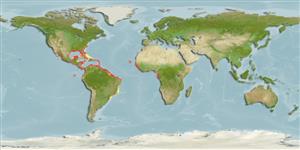分类 / Names
俗名 | 同种异名 | Catalog of Fishes(属, 种) | ITIS | CoL | WoRMS | Cloffa
Environment: milieu / climate zone / depth range / distribution range
生态学
海洋; 半咸淡水 礁区鱼类; 深度上下限 0 - 100 m (Ref. 9710), usually ? - 46 m (Ref. 55295). 亞熱帶的; 36°N - 33°S, 121°W - 12°E (Ref. 55295)
Western Atlantic: Florida, USA to southern Brazil, including the Gulf of Mexico and the Caribbean. Eastern Atlantic: Senegal to Congo (reported as Epinephelus esonue, Ref. 2739, 6809); rare in Canary Islands (Ref. 6808). Eastern Pacific (Gulf of California to Peru) species refers to Epinephelus quinquefasciatus. Discrete populations of E. itajara exist in the western Atlantic (Ref. 89627).
西大西洋: 美國佛羅里達到巴西南部, 包括墨西哥灣與加勒比海。 東大西洋: 塞內加爾到剛果;(報告如 伊索石斑魚〔Epinephelus esonue〕 , 參考文獻 2739,6809) 稀有的在加納利群島.(參考文獻 6808) 東太平洋: 加州灣到祕魯。
Length at first maturity / 大小 / 重量 / 年龄
Maturity: Lm 128.0 range ? - ? cm
Max length : 250 cm TL 雄鱼/尚未辨别雌雄; (Ref. 26550); common length : 150 cm TL 雄鱼/尚未辨别雌雄; (Ref. 5217); 最大体重: 455.0 kg (Ref. 4841); 最大年龄: 37 年 (Ref. 4841)
背棘 (总数) : 11; 背的软条 (总数) : 15 - 16; 臀棘: 3; 臀鳍软条: 8. Distinguished by the following characteristics: brownish yellow, grey or greenish body color; head and dorsal part of body and fins with small black spots; body robust and elongate; body depth contained 2.7-3.4 times in SL; HL 2.3-2.9 in SL; extremely broad head; flat interorbital; rounded preopercle, finely serrate; round nostrils, subequal; maxilla scaly, reaching well past eye; 3-5 rows of subequal teeth on midlateral part of lower jaw; absence of canines at front jaw (Ref. 89707); further characterized by having opercle with 3 flat spines, middle one the largest. Pelvic fins smaller than the pectorals. Bases of soft dorsal and anal fins covered with scales and thick skin. Juveniles tawny with irregular vertical bands.
头部长的。 鳃盖有 3根平坦的棘,中央一最大的。 比胸鳍小的腹鳍。 软背鳍与臀鳍的基底覆盖着鳞片与厚的皮肤了。 稚鱼黄褐色有不规则的垂直条纹。
A solitary species (Ref. 26340) occurring in shallow, inshore areas. Found on rock, coral, or mud bottoms (Ref. 5217). Juveniles found in mangrove areas and brackish estuaries (Ref. 5217). Large adults may be found in estuaries (Ref. 5217). Adults appear to occupy limited home ranges with little inter-reef movement. Feeds primarily on crustaceans, particularly spiny lobsters as well as turtles and fishes, including stingrays. Territorial near its refuge cave or wreck where it may show a threat display with open mouth and quivering body. Larger individuals have been known to stalk and attacks divers. Over-fished, primarily by spear fishing (Ref. 9710). Marketed fresh and salted. Meat is of excellent quality. Important game fish (Ref. 9342). Reported to reach weights of more than 315 kg (Ref. 26938).
出现在浅滩,沿海地区区域的一种独居性种 (参考文献 26340)。 栖息于岩石,珊瑚或泥底了。 (参考文献 5217) 稚鱼发现于红树林区域与半咸淡水河口了。 (参考文献 5217) 大的成鱼可能被发现于河口。 (参考文献 5217) 成鱼似乎占领限制家庭的范围有小的在礁之间的运动。 主要吃甲壳动物, 特别地棘龙虾以及海龟与鱼, 包括 。 领域性靠近它是藏身处洞穴或者残骸在哪里它可能显示一个威胁显现开放的嘴而且颤抖身体。 较大的个体曾经知道悄悄靠近而且尝试吃潜水者。 被过度渔捞, 主要地藉着鱼矛渔法。 (参考文献 9710) 在市场上销售生鲜地了与盐腌的。 肉是有优良品质的。 重要的游钓鱼类.(参考文献 9342) 报告达到超过 315 公斤的重量。 (参考文献 26938)
Life cycle and mating behavior
成熟度 | 繁殖 | 产卵场 | 卵 | 孕卵数 | 仔鱼
西大西洋: 美國佛羅里達到巴西南部, 包括墨西哥灣與加勒比海。 東大西洋: 塞內加爾到剛果;(報告如 伊索石斑魚〔Epinephelus esonue〕 , 參考文獻 2739,6809) 稀有的在加納利群島.(參考文獻 6808) 東太平洋: 加州灣到祕魯。
Heemstra, P.C. and J.E. Randall, 1993. FAO Species Catalogue. Vol. 16. Groupers of the world (family Serranidae, subfamily Epinephelinae). An annotated and illustrated catalogue of the grouper, rockcod, hind, coral grouper and lyretail species known to date. Rome: FAO. FAO Fish. Synop. 125(16):382 p. (Ref. 5222)
世界自然保护联盟红皮书 (Ref. 130435: Version 2024-2)
人类利用
渔业: 低经济; 游钓鱼种: 是的
工具
特别资料
下载 XML
网络资源
Estimates based on models
Preferred temperature (Ref.
123201): 22.8 - 28, mean 26.3 °C (based on 532 cells).
Phylogenetic diversity index (Ref.
82804): PD
50 = 0.5000 [Uniqueness, from 0.5 = low to 2.0 = high].
Bayesian length-weight: a=0.01096 (0.00638 - 0.01885), b=3.03 (2.89 - 3.17), in cm total length, based on LWR estimates for this species & Genus-body shape (Ref.
93245).
营养阶层 (Ref.
69278): 4.1 ±0.0 se; based on diet studies.
Generation time: 8.7 ( na - na) years. Estimated as median ln(3)/K based on 1
growth studies.
回复力 (Ref.
120179): 低的, 最小族群倍增时间4.5 - 14 年 (K=0.13; tm=5.5-6.5).
Fishing Vulnerability (Ref.
59153): High to very high vulnerability (70 of 100).
Nutrients (Ref.
124155): Calcium = 7.75 [2.67, 16.99] mg/100g; Iron = 0.365 [0.171, 0.783] mg/100g; Protein = 19.9 [18.3, 21.5] %; Omega3 = 0.169 [0.084, 0.334] g/100g; Selenium = 25.9 [11.7, 60.3] μg/100g; VitaminA = 40.7 [8.5, 195.4] μg/100g; Zinc = 0.626 [0.390, 0.977] mg/100g (wet weight);
